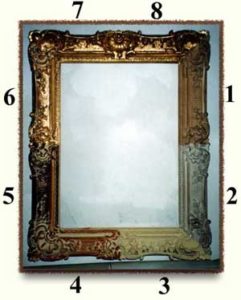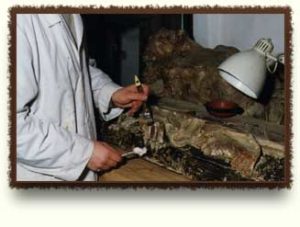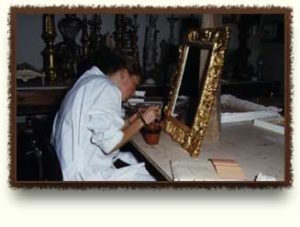The gilder is a member of a largely artisan profession. He or she has ornamental design skills of various styles and is familiar with the characteristics of the different types of gold and silver leaf used in wood gilding. He or she is capable of replicating ar restoring works of art of varying stiles, with the required sensitivity and technical xpertise.
|
GOLD LEAFING AND RESTORATION OF WORKS OF GILDED WOOD (3 HOURS)
Theory: (1 hour) Introduction to the art of gilding, including presentations of the materials used and decorative techniques with regard to the historical period of the piece. Water gilding and gilding with the use of Gold size.Introduction to the techniques of restoration of painted and gilded wooden pieces.
Practice: (2 hours) Goldleafing with the use of gold size on a small wooden object in the Florentine style, and techniques of antiquing. (The wooden object, provided by the school for this exercise, will remain with the students as a memento of their experience.)
Places Available: Maximum of 25 per course |
| GILDING AND RESTORATION OF GILDED WORKS OF ART – 5 days
Day 1 Monday – 4 hours
Introduction to the art of gilding, presentation of materials and general decorative techniques.
Choosing the object for the project.
Applying the gesso.
Day 2 Tuesday – 4 hours
Preparing the surfaces to be gilded. Applying the bole.
Gilding the object
Day 3 Wednesday – 4 hours
Burnishing the gold and antiquing
Day 4 Thursday – 4 hours
Preparation and application of a special lacquer specifically made for the decorative technique known as “graffito”.
Day 5 Friday – 4 hours
Final finishing of the object.
Participants get to keep the finished object. |
|
WORK PLAN (80 hour programme)
Introduction to the art of gilding including the presentation of it’s materials and decorative techniques.
- Water-gilding:
- – The uses of Bologna gesso
- – The specific use of rabbit-skin and fish glues
- – Bole, historical outline and technical properties
- – Application and use of the bole
- – Sgraffito
- – Punching
- – Pastiglia
- – Burnished gold
- – Matt gold
- – Ageing techniques on real gold
- – Technical properties of the metals used in water-gilding (real gold, brass, silver and aluminium)
- – The mecca (gilt varnish)
- Mordant:
- – The technique and presentation of its materials (general information)
- – Shellac
- – Acrylic mordants, their technical properties and use
- – Oil mordants, their technical properties and use
- – Ageing techniques for mordant-gilded object
- Decorative techniques:
- – Craquelure
- – Marbling on frames, it’s most common usage
By the end of this part of the programme, students will be acquainted with all the techniques of frame decoration. The programme then continues with: the introduction to the profession of restoration
Water-gilding
 |
1. WOOD
|
2. GLUE
|
| 3. GESSO |
4. RED BOLE
|
5. BROWN BOLE
|
6. GILDING
|
7. AGEING
|
8. FINAL AGEING AND TONING
|
|
|
WORK PLAN (320 hour programme)
Following the 80 hour introductory course, the programme continues as follows. Presentation of technical issues analysis of an objects economic and historical value, ethical and technical evaluations.
- Introduction to materials
- Facing
- Consolidation of wood:
- – With animal glues
- – With synthetic substances
- Disinfestation
- Consolidation of original imprimatur:
- – Tests on original pieces using various techniques and materials
- Consolidation of antique lacquers
- Cleaning:
- – Tests on original pieces of various periods and styles
- – Use of different solvents on water-gilt and mordant-gilt objects as well as on gilt varnish and lacquers
- – Mechanical (scalpels)
- Filling:
- – With the aid of various techniques and materials suited to the particular object
- Integration techniques:
- Using metal leaf and both water and mordant gilding
- Using bole and colour lacquers
- Neutral integration:
- By cromatic selection or cromatic abstraction
- With the use of water colour and varnish-based colours
- Reconstruction of Pastiglia with:
- Gesso and silicone moulds with different characteristics
- Ageing techniques:
- Abrasion, toning, varnishes, patina.
Naturally, each above-mentioned process is carried out on original objects of various epochs and styles.

Consolidation of wood
|

Water-gilding techniques
|
|


